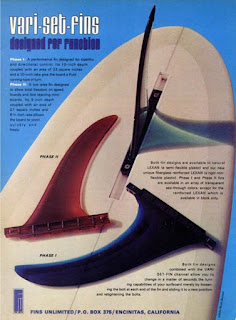Let's take a thumbnail look at the progression...
George Downing developed what's generally considered the first fin box, C 1951...
This is a removable teak fin made for one of Downing's customers a few years later...
Hobie built a Makaha gun with a fin box in 1955...
There were several crude removable fin systems used in the early-to-mid 60s, delineated here.
Tom Morey began to penetrate the U.S. surf industry around 1964 with his semi-permanent fin system. The fins were press fit into the box, then secured with resin.
This is a molded plastic Yater design from Morey Skeg Works...
Here's a Greenough Stage 2 from the Skeg Works...
The Wonderbolt was next for Morey. It was similar to the Skeg Works resin-bond approach, but had a bolt in the back of the fin that would "back out" and secure the fin in the box. Fins could be removed and/or replaced in a matter of seconds. More fin designs were offered, like this Weber Hatchet...
...or this Greenough Stage 3...
Greg Noll used a similar system on their own boards...
A couple of years later, Tom Morey generated mainstream acceptance of removable fins with his WAVE Set box. It featured a number of fin designs from established builders like Yater, Harbour, G&S, Bing, Weber, and O'Neill...
Weber Hatchet Fin
O'Neill Raked Kelp Fin
G&S/Skip Frye High Drift Mini Fin
...not to mention the Stage 3 power surfing fin from indie designer George Greenough...
Down in San Diego, Bill Bahne answered Morey's Ventura-based effort with the Fins Unlimited system in 1968. It was smaller and lighter than the WAVE Set system, but not as well bonded into the board...
The WAVE box had a wide lip that was glassed over, making it much more durable...
Bahne also offered fewer fin designs to choose from...
Linda Benson with a board using the early Fins Unlimited system.
Like Greg Noll, Hobie went with an in-house unit from the end of the longboard era through the transition era. It also utilized a single through-bolt from the deck into the fin.
All these units worked fairly well in small surf, but the placement of the fin was determined by the builder. There was no chance a surfer could alter the location of the box once it was installed.
The next step forward was a moveable fin system in 1969.
In deference to his existing customer base, Morey utilized a sub-unit that would bolt into the original WAVE Set boxes.
The newly minted Greenough Stage 4 fin, with its narrow base, was well suited to the concept. There was plenty of room for back and forth adjustment...
Taking a different approach, Fins Unlimited introduced an entirely new adjustable unit, the Vari-Set. There were only two fins available to fit the box, a short pivot fin and a longer power surfing fin...
Like it's FU predecessor, the Vari-Set was flimsy as hell, and prone to cracking around the corners...
Hansen developed their system that utilized a single anchor bolt, a long box, and a fin with multiple bolt receptors, allowing for movement...
Bing also made their own fin box called "Guidance System." Boltless and adjustable, the fin snapped into the box without screws to hold it in place. Since plastic is so malleable, the fin would work loose over time, so it was short lived...
The chaos finally abated in 1970, when Fins Unlimited introduced a fin box that addressed most of the issues presented by the older units...
Individually made fiberglass fins became the norm, and shortboard surfing took a quantum leap forward...
Since its inception, the Fins Unlimited box was a key factor in the advancement of displacement hulls. It remains the single fin standard today...
Imagine how many waves have been traversed with boards utilizing the Fins Unlimited fin box over the past 5 decades...millions!











































No comments:
Post a Comment